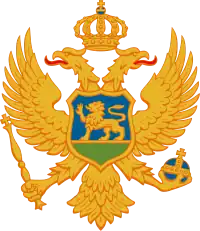| Total population | |
|---|---|
| 3,127 (2021)[1] | |
| Regions with significant populations | |
| City of Zagreb, Istria County, Primorje-Gorski Kotar County, Split-Dalmatia County, Osijek-Baranja County, Dubrovnik-Neretva County | |
| Languages | |
| Montenegrin, Croatian | |
| Religion | |
| Montenegrin Orthodox, Roman Catholic and Muslim minority | |
| Related ethnic groups | |
| Montenegrins |
| Part of a series on |
| Montenegrins |
|---|
 |
| By region or country |
| Recognized populations |
|
Montenegro Serbia Bosnia and Herzegovina Croatia North Macedonia Kosovo Albania |
| Diaspora |
|
|
|
|
| Culture |
|
| Religion |
|
Catholicism Islam |
| Language and dialects |
| History |
|
History of Montenegro Rulers |
The Montenegrins of Croatia are a national minority in the republic. According to the 2021 census, there are 3,127 ethnic Montenegrins in Croatia. The highest number of Montenegrins in Croatia is in the Croatian capital Zagreb.
Montenegrins are officially recognized as an autochthonous national minority, and as such, they elect a special representative to the Croatian Parliament, shared with members of four other national minorities.[2]
History
In 1657, the Doge of Venice Bertuccio Valiero, resettled Peroj with five families (Brcela, Draković, Brajić, Vučeta, and Ljubotina) from the Cernizza region in Montenegro. Following the Cretan War of 1645–1669, twenty other families originally from Montenegro migrated to Peroj. Today Peroj is the centre of the Montenegrins in Istria County.
Demographics
Montenegrins in census for 2001 and 2011:
| County | Number in 2001 census | % of all Montenegrins in Croatia |
Number in 2011 census | % of all Montenegrins in Croatia |
|---|---|---|---|---|
| City of Zagreb | 1,313 | 26.65% | 1,191 | 26.37% |
| Istria County | 732 | 14.86% | 759 | 16.80% |
| Primorje-Gorski Kotar County | 643 | 13.05% | 642 | 14.21% |
| Split-Dalmatia County | 593 | 12.04% | 485 | 10.74% |
| Dubrovnik-Neretva County | 370 | 7.51% | 307 | 6.80% |
| Osijek-Baranja County | 352 | 7.15% | 319 | 7.08% |
| Zagreb County | 135 | 2.74% | 130 | 2.88% |
| Vukovar-Srijem County | 119 | 2.41% | 97 | 2.15% |
| Zadar County | 112 | 2.27% | 100 | 2.21% |
| Bjelovar-Bilogora County | 83 | 1.68% | 63 | 1.39% |
| Šibenik-Knin County | 75 | 1.52% | 66 | 1.46% |
| Karlovac County | 74 | 1.50% | 62 | 1.37% |
| Sisak-Moslavina County | 70 | 1.42% | 68 | 1.51% |
| Brod-Posavina County | 54 | 1.10% | 41 | 0.91% |
| Virovitica-Podravina County | 43 | 0.87% | 42 | 0.93% |
| Varazdin County | 42 | 0.85% | 43 | 0.95% |
| Međimurje County | 31 | 0.63% | 26 | 0.58% |
| Koprivnica-Krizevci County | 29 | 0.59% | 36 | 0.80% |
| Pozega-Slavonia County | 22 | 0.45% | 14 | 0.31% |
| Krapina-Zagorje County | 13 | 0.26% | 10 | 0.22% |
| Lika-Senj County | 8 | 0.16% | 16 | 0.35% |
| Total | 4,926 | 100% | 4,517 | 100% |
See also
References
- ↑ "Population by Ethnicity, by Towns/Municipalities, 2011 Census". Census of Population, Households and Dwellings 2011. Zagreb: Croatian Bureau of Statistics. December 2012.
- ↑ "Pravo pripadnika nacionalnih manjina u Republici Hrvatskoj na zastupljenost u Hrvatskom saboru". Zakon o izborima zastupnika u Hrvatski sabor (in Croatian). Croatian Parliament. Retrieved 2011-12-29.
Sources
External links
- National Union of Montenegrins in Rijeka
- Council of the Montenegrin National Minority in the City of Zagreb